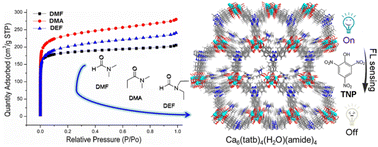The role of terminal coordinated amides in a series of Ca-tatb frameworks: pore size regulation and fluorescence sensing tunability†
Abstract
Pore size tunability is of great importance to porous materials with applications in sieving adsorption, barrier separation, stereospecific catalysis, and so forth. In this work, we present three calcium based metal organic frameworks (Ca-MOFs) with tunable pore sizes. The title Ca-MOFs of [Ca6(tatb)4(H2O)(amide)4] (H3tatb = 4,4′,4′′-(1,3,5-triazine-2,4,6-triyl)tribenzoic acid, amide = dimethylformamide (DMF) for 1, dimethylacetamide (DMA) for 2, and formyldiethylamine (DEF) for 3, respectively) featuring three dimensional (3D) structures were constructed from inorganic 1D rod-like secondary building units (SBUs) of [Ca(COO)4(amide)]n and the organic linker of H3tatb. Interestingly, by altering the terminal coordinated amides with alkyl groups extended into the 1D pores, the pore sizes of title compounds could be finely regulated. As a result, these compounds exhibited pore size dependent fluorescence sensing behavior towards trinitrophenol (TNP), a classic explosive molecule. Different from that in previous studies, this work strategically employs terminal coordinated amides, which typically get removed to create porosity, to tune the pore sizes of the resultant Ca-MOFs, providing a convenient way to modify the pore structures of porous materials.

- This article is part of the themed collection: 2023 Journal of Materials Chemistry C HOT Papers


 Please wait while we load your content...
Please wait while we load your content...